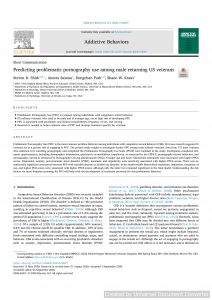Mental Health
Predicting Problematic Pornography Use Among Male Returning US Veterans
 Full Article Name: Predicting Problematic Pornography Use Among Male Returning US Veterans
Full Article Name: Predicting Problematic Pornography Use Among Male Returning US Veterans
Open Access: Yes
Abstract
Problematic Pornography Use (PPU) is the most common problem behavior among individuals with compulsive sexual behavior (CSB). Previous research suggests US veterans are at a greater risk of engaging in PPU. The present study sought to investigate further PPU among male military veterans. Data from 172 male veterans who endorsed ever watching pornography and completed the Problematic Pornography Use Scale (PPUS) were included in the study. Participants completed self-report questionnaires, including demographic information, psychiatric co-morbidities, impulsivity, as measured by the UPPS-P, pornography-related behaviors, and pornography craving as measured by Pornography Craving Questionnaire (PCQ). Younger age and lower educational attainment were associated with higher PPUS scores. Depression, anxiety, post-traumatic stress disorder (PTSD), insomnia, and impulsivity were positively associated with higher PPUS scores. There was no statistically significant association between PPU with suicidal ideation or alcohol use disorder. In the multivariable hierarchical regression, depression, frequency of use, and higher PCQ scores were associated with higher PPUS scores, although only the latter two remained significant in the final model. Understanding the risk factors via more frequent screening for PPU will help with the development of treatment protocols for this problematic behavior.
Citation
Shirk, S. D., Saxena, A., Park, D., & Kraus, S. W. (2021). Predicting problematic pornography use among male returning us veterans. Addictive Behaviors, 112. https://doi.org/10.1016/j.addbeh.2020.106647
